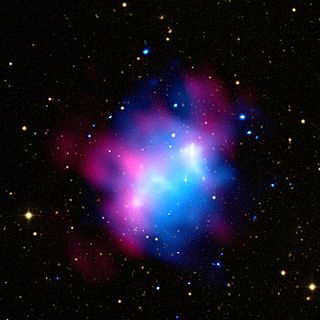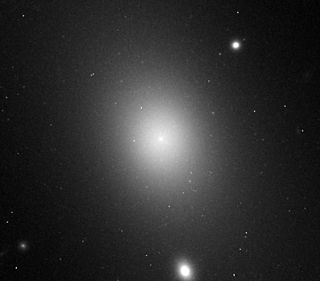
A galaxy cluster, or a cluster of galaxies, is a structure that consists of anywhere from hundreds to thousands of galaxies that are bound together by gravity, with typical masses ranging from 1014 to 1015 solar masses. They are the second-largest known gravitationally bound structures in the universe after some superclusters (of which only one, the Shapley Supercluster, is known to be bound). They were believed to be the largest known structures in the universe until the 1980s, when superclusters were discovered. One of the key features of clusters is the intracluster medium (ICM). The ICM consists of heated gas between the galaxies and has a peak temperature between 2–15 keV that is dependent on the total mass of the cluster. Galaxy clusters should not be confused with galactic clusters (also known as open clusters), which are star clusters within galaxies, or with globular clusters, which typically orbit galaxies. Small aggregates of galaxies are referred to as galaxy groups rather than clusters of galaxies. The galaxy groups and clusters can themselves cluster together to form superclusters.
In modern physical cosmology, the cosmological principle is the notion that the spatial distribution of matter in the universe is uniformly isotropic and homogeneous when viewed on a large enough scale, since the forces are expected to act equally throughout the universe on a large scale, and should, therefore, produce no observable inequalities in the large-scale structuring over the course of evolution of the matter field that was initially laid down by the Big Bang.

The Virgo Supercluster or the Local Supercluster is a mass concentration of galaxies containing the Virgo Cluster and Local Group, which itself contains the Milky Way and Andromeda galaxies, as well as others. At least 100 galaxy groups and clusters are located within its diameter of 33 megaparsecs. The Virgo SC is one of about 10 million superclusters in the observable universe and is in the Pisces–Cetus Supercluster Complex, a galaxy filament.

A radio galaxy is a galaxy with giant regions of radio emission extending well beyond its visible structure. These energetic radio lobes are powered by jets from its active galactic nucleus. They have luminosities up to 1039 W at radio wavelengths between 10 MHz and 100 GHz. The radio emission is due to the synchrotron process. The observed structure in radio emission is determined by the interaction between twin jets and the external medium, modified by the effects of relativistic beaming. The host galaxies are almost exclusively large elliptical galaxies. Radio-loud active galaxies can be detected at large distances, making them valuable tools for observational cosmology. Recently, much work has been done on the effects of these objects on the intergalactic medium, particularly in galaxy groups and clusters.
The Lambda-CDM, Lambda cold dark matter, or ΛCDM model is a mathematical model of the Big Bang theory with three major components:
- a cosmological constant denoted by lambda (Λ) associated with dark energy
- the postulated cold dark matter
- ordinary matter

Radio halos are large-scale sources of diffuse radio emission found in the center of some, but not all, galaxy clusters. There are two classes of radio halos: mini-halos and giant radio halos. The linear size of giant radio halos is about 700kpc-1Mpc, whereas mini-halos are typically less than 500kpc. Giant radio halos are more often observed in highly X-ray luminous cluster samples than less luminous X-ray clusters in complete samples. They have a very low surface brightness and do not have obvious galaxy counterparts. However, their morphologies typically follow the distribution of gas in the intra-cluster medium. Mini-halos however, while similar to giant halos, are found at the center of cooling core clusters but around a radio galaxy.

The Perseus cluster is a cluster of galaxies in the constellation Perseus. It has a recession speed of 5,366 km/s and a diameter of 863′. It is one of the most massive objects in the known universe, containing thousands of galaxies immersed in a vast cloud of multimillion-degree gas.

IC 1101 is a class S0 supergiant (cD) lenticular galaxy at the center of the Abell 2029 galaxy cluster. It has an isophotal diameter at about 123.65 to 169.61 kiloparsecs. It possesses a diffuse core which is the largest known core of any galaxy to date, and contains a supermassive black hole, one of the largest discovered. The galaxy is located at 354.0 megaparsecs from Earth. The galaxy was discovered on 19 June 1790, by the British astronomer William Herschel.

The Comet Galaxy, a spiral galaxy located 3.2 billion light-years from Earth, in the galaxy cluster Abell 2667, was found with the Hubble Space Telescope. This galaxy has slightly more mass than our Milky Way. It was detected on 2 March 2007.

In cosmology, the steady-state model or steady state theory is an alternative to the Big Bang theory. In the steady-state model, the density of matter in the expanding universe remains unchanged due to a continuous creation of matter, thus adhering to the perfect cosmological principle, a principle that says that the observable universe is always the same at any time and any place.

Abell 2744, nicknamed Pandora's Cluster, is a giant galaxy cluster resulting from the simultaneous pile-up of at least four separate, smaller galaxy clusters that took place over a span of 350 million years, and is located approximately 4 billion light years from Earth. The galaxies in the cluster make up less than five percent of its mass. The gas is so hot that it shines only in X-rays. Dark matter makes up around 75 percent of the cluster's mass.
Abell 2256 is a rich nearby galaxy cluster in the Abell catalogue that exhibits a population of ~ 100 – 200 kpc long steep spectrum synchrotron filaments surrounding the cluster center with significant evidence of merger activity deduced by the presence of two separate X-ray peaks in the X-ray surface brightness distribution. One feature is a radio 'relic'. The other striking feature in the cluster is a long tail whose morphology suggests it is either a one-sided jet or a twin-tail structure. The bending of the tails takes place very near the galaxy core where one might expect little impact from the galaxy's motion through the intergalactic medium, unless the parent galaxy has undergone extreme stripping.
Abell 2061 is a galaxy cluster in the constellation of Corona Borealis. On a larger scale still, Abell 2061, along with Abell 2065, Abell 2067, Abell 2079, Abell 2089, and Abell 2092, make up the Corona Borealis Supercluster. It has a northeast southwest orientation and Abell 2067 lies 1.8 megaparsecs north of it.
Abell 2067 is a galaxy cluster in the constellation of Corona Borealis. On a larger scale, Abell 2067, along with Abell 2061, Abell 2065, Abell 2079, Abell 2089, and Abell 2092, make up the Corona Borealis Supercluster. Abell 2061 lies 1.8 megaparsecs south of it and the two are likely interacting.
Centrifugal acceleration of astroparticles to relativistic energies might take place in rotating astrophysical objects. It is strongly believed that active galactic nuclei and pulsars have rotating magnetospheres, therefore, they potentially can drive charged particles to high and ultra-high energies. It is a proposed explanation for ultra-high-energy cosmic rays (UHECRs) and extreme-energy cosmic rays (EECRs) exceeding the Greisen–Zatsepin–Kuzmin limit.

NGC 3311 is a super-giant elliptical galaxy located about 190 million light-years away in the constellation Hydra. The galaxy was discovered by astronomer John Herschel on March 30, 1835. NGC 3311 is the brightest member of the Hydra Cluster and forms a pair with NGC 3309 which along with NGC 3311, dominate the central region of the Hydra Cluster.

NGC 708 is an elliptical galaxy located 240 million light-years away in the constellation Andromeda and was discovered by astronomer William Herschel on September 21, 1786. It is classified as a cD galaxy and is the brightest member of Abell 262. NGC 708 is a weak FR I radio galaxy and is also classified as a type 2 Seyfert galaxy.

NGC 753 is a spiral galaxy located 220 million light-years away in the constellation Andromeda. The galaxy was discovered by astronomer by Heinrich d'Arrest on September 16, 1865 and is a member of Abell 262.

NGC 759 is an elliptical galaxy located 230 million light-years away in the constellation Andromeda. NGC 759 was discovered by astronomer by Heinrich d'Arrest on September 17, 1865. It is a member of Abell 262.

NGC 4302 is an edge-on spiral galaxy located about 55 million light-years away in the constellation Coma Berenices. It was discovered by astronomer William Herschel on April 8, 1784 and is a member of the Virgo Cluster.














